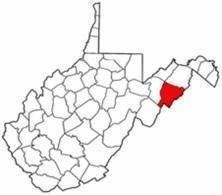
AIR QUALITY click here
Welcome to
Hardy County, West Virginia
Hardy County was created from Hampshire County in 1786, and named for Samuel Hardy, a distinguished Virginian. The first entry in the Hardy County Court record book states that the Court met on February 7, 1786, at the house of William Bullitt. At a Court held at the same house on March 7, 1786, it was ordered that the Sheriff let the Court House at the next April Court to the lowest bidder. It was to be built of logs with diamond corners and to be hewn down inside and outside and measure 26 ft. by 22 ft. It was to have a story and one half with a stone or brick chimney.
The second court house was built on the corner of Winchester and Franklin Streets (now South Elm Street) in 1792-93 by Abel Seymour, added to in 1833 and used as the Court House until 1860 and has since housed offices, apartments, and a day and boarding school for girls. The building still stands and currently is used for apartments.
The third Court House was built in 1859-60 on South Main Street. Plans housed in the Clerk's office show the arranger (designer) as Col. Jno. B. Baldwin and the plans were drawn by Wm. A. Pratt. William Eberly from Moorefield was the builder. The building is still standing although greatly altered in appearance. After 1914 store fronts were added to the structure and since then it has been used by various retail establishments and as an apartment house.
During the fractious period of the Civil War the Court met irregularly and at least once outside the Court House. The meeting was at the house of John Mathias on Lost River on May 2, 1864. This log house is standing and has been partially restored.
The present Court House was built during 1911-1914 on the corner of Washington and Elm Streets. The architects were Millburn, Heister and Co. of Washington, DC. It was declared to be the official home of the Court beginning August 24, 1914. In 1985, the building was extensively renovated inside and an addition constructed on the north side. The architect for the addition was Grandee, Thomas & Sprouse of Charleston, WV. Except for the north side, the facade of the original building remains nearly unchanged from its original design. In today's society where the display of the Ten Commandments in Court Houses is hotly debated it is interesting to note that between Feburary 6, 1920, and March 12, 1922, the Methodists held Sunday services in the Court House while their new church was under construction.
Compiled July 2005 by Eleanor L. Heishman

